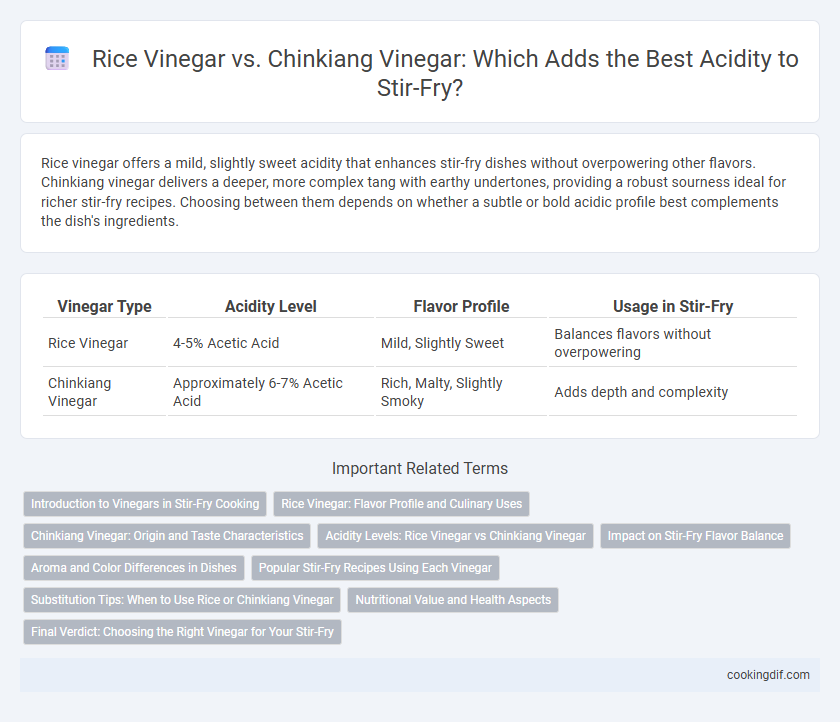Rice vinegar offers a mild, slightly sweet acidity that enhances stir-fry dishes without overpowering other flavors. Chinkiang vinegar delivers a deeper, more complex tang with earthy undertones, providing a robust sourness ideal for richer stir-fry recipes. Choosing between them depends on whether a subtle or bold acidic profile best complements the dish's ingredients.
Table of Comparison
| Vinegar Type | Acidity Level | Flavor Profile | Usage in Stir-Fry |
|---|---|---|---|
| Rice Vinegar | 4-5% Acetic Acid | Mild, Slightly Sweet | Balances flavors without overpowering |
| Chinkiang Vinegar | Approximately 6-7% Acetic Acid | Rich, Malty, Slightly Smoky | Adds depth and complexity |
Introduction to Vinegars in Stir-Fry Cooking
Rice vinegar, known for its mild acidity and subtle sweetness, enhances stir-fry dishes without overpowering other flavors, making it ideal for balancing delicate ingredients like vegetables and seafood. Chinkiang vinegar, a dark, aged black rice vinegar, offers a stronger, more complex acidity with smoky and umami notes, enriching heartier stir-fry recipes such as those with beef or pork. Understanding the acidity profiles and flavor nuances of these vinegars allows cooks to tailor the taste intensity and depth in stir-fry cooking for optimal results.
Rice Vinegar: Flavor Profile and Culinary Uses
Rice vinegar offers a mild acidity with subtle sweetness, making it a versatile ingredient in stir-fry dishes that balances flavors without overpowering other components. Its gentle tang enhances vegetables, meats, and sauces, contributing light brightness and depth commonly preferred in Asian cuisines. Unlike the bolder, smoky Chinkiang vinegar, rice vinegar's delicate flavor profile allows it to seamlessly complement a wide range of stir-fry recipes.
Chinkiang Vinegar: Origin and Taste Characteristics
Chinkiang vinegar, originating from China's Jiangsu Province, offers a deep, rich umami flavor with a subtle sweetness and smoky undertone, making it more complex than the sharper, milder acidity of rice vinegar. Its fermentation process using glutinous rice and various grains contributes to its dark color and robust taste, ideal for enhancing stir-fry dishes with bold, layered acidity. Compared to rice vinegar, Chinkiang vinegar provides a fuller-bodied acidity that balances richness while imparting a distinctive aromatic profile.
Acidity Levels: Rice Vinegar vs Chinkiang Vinegar
Rice vinegar typically has a mild acidity level around 4%, contributing a subtle tang without overpowering dishes, making it ideal for lighter stir-fry flavors. Chinkiang vinegar, a black rice vinegar, features a higher acidity level closer to 5%, with a rich, complex taste that adds depth and umami to stir-fries. Selecting between the two depends on desired acidity intensity and flavor profile, with rice vinegar offering gentle sharpness and Chinkiang vinegar delivering bold, robust acidity.
Impact on Stir-Fry Flavor Balance
Rice vinegar offers a mild acidity that enhances stir-fry dishes with subtle tanginess and a slightly sweet undertone, preserving the natural flavors of vegetables and proteins. Chinkiang vinegar, a dark Chinese black vinegar, delivers a deeper, more complex acidity with earthy and smoky notes that add richness and depth to stir-fry sauces. The choice between rice vinegar and Chinkiang vinegar directly impacts flavor balance by either highlighting freshness or introducing a robust, savory complexity in stir-fry recipes.
Aroma and Color Differences in Dishes
Rice vinegar offers a mild acidity with a subtle, slightly sweet aroma that enhances dishes without overpowering flavors, producing a clear, pale color in stir-fry sauces. Chinkiang vinegar, a black rice vinegar, delivers a deeper, more complex acidity with smoky, earthy notes and a dark amber hue that intensifies the visual appeal of stir-fry dishes. Choosing between these vinegars impacts not only the acidity level but also the aromatic depth and coloration, influencing the overall sensory profile of the meal.
Popular Stir-Fry Recipes Using Each Vinegar
Rice vinegar offers a mild, slightly sweet acidity that enhances the flavor of popular stir-fry dishes like chicken and vegetable stir-fry or shrimp with snap peas. Chinkiang vinegar, known for its deep, rich, and complex acidity with smoky undertones, is ideal for more robust recipes such as beef stir-fry with black bean sauce or braised pork with vegetables. Each vinegar's distinct acidity profile influences the taste and balance, making rice vinegar perfect for light and fresh stir-fries, while Chinkiang vinegar elevates heavier, savory dishes.
Substitution Tips: When to Use Rice or Chinkiang Vinegar
Rice vinegar offers a mild, slightly sweet acidity perfect for light stir-fry dishes and delicate vegetable flavors, while Chinkiang vinegar provides a robust, smoky tang ideal for heartier meats and bold sauces. When substituting, use rice vinegar to maintain subtle sourness without overpowering, and choose Chinkiang vinegar when a deeper, complex acidity is needed. Adjust quantities accordingly, as Chinkiang vinegar's stronger flavor means less is required to achieve the desired taste balance.
Nutritional Value and Health Aspects
Rice vinegar contains mild acetic acid and fewer calories, making it a lighter option with trace amounts of amino acids and antioxidants beneficial for digestion when used in stir-fry. Chinkiang vinegar, a black rice vinegar, is richer in organic acids, including lactic and acetic acids, which contribute to its deeper acidity and potential probiotic effects that support gut health. Both vinegars offer low sodium levels but differ in antioxidant content, with Chinkiang vinegar providing more polyphenols that may enhance cardiovascular benefits.
Final Verdict: Choosing the Right Vinegar for Your Stir-Fry
Rice vinegar offers a mild, slightly sweet acidity that enhances stir-fry without overpowering other flavors, making it ideal for delicate dishes and everyday cooking. Chinkiang vinegar delivers a robust, complex acidity with smoky and umami notes, perfect for adding depth and boldness to richer stir-fry recipes. Choosing the right vinegar depends on the desired flavor profile: use rice vinegar for subtle brightness and Chinkiang vinegar for intense, savory richness.
Rice vinegar vs Chinkiang vinegar for acidity Infographic

 cookingdif.com
cookingdif.com